This text was automatically translated by a robot. I apologize for any grammar mistakes.
In the year 2016, a pilgrimage to Mariazell aroused my desire to wander far; In the same year, we Rundumadum the city of Vienna in the course of the “route”, and in the year 2017 we walked in two days from Vienna to Hainburg. All these little hiking adventures were for us exciting experiences in which we have gone to our physical limits and have grown closer together with our friends. So now it’s time for a little update: What are the possibilities for pilgrimage and long-distance hiking in Vienna and the surrounding area? I have made a smart time and summarize here a few highlights, which we will probably see in the coming years.
1. Santiago Route Vienna
The Santiago Route Vienna leads from Schwechat along the Danube, into the federal capital up to St. Stephen’s Cathedral, the architectural highlight of the journey. From there it continues through the city to Schönbrunn Palace, and from there to Purkersdorf, where the Vienna section of the world’s most famous pilgrimage trail ends. According to the organizers, the total length of the route is 35.5 kilometres, which means that it is possible to cope in a single day for well-trained hikers-the question is, however, whether you actually go to sweat bathed by the busy streets of downtown Vienna Want to. The alternative would be to go just the 12.5 kilometre short stage from Schwechat to Kaiser Mills-which is a nice trip for a sunny Sunday.
Below is a map of the hike, more information can be found at Https://www.jakobsweg-wien.at/verlauf-und-uebersicht
2. Santiago route from Purkersdorf to Göttweig
After the Vienna section of the Pilgrim, the stage follows between Purkersdorf and Göttweig. This starts in the Vienna Woods, then reaches the foothills of the Tulln field; Further highlights are the Abbey Herzogesnburg and the foothills of the Dunktelsteiner Forest, as well as the arrival in the Benedictine monastery of Göttweig. This is a Gesamtsrecke of 74.02 kilometers, with 1799 meters ascent and 1806 meters descent. As an experienced hiker you should plan two, better even three days.
3. Martinusweg
I was still completely unaware of the Martinusweg, but among Christian pilgrims this is obviously a topic: A pilgrimage route opened 2016 on the occasion of the 1700 anniversary of Saint Martin and from Hungarian Szombathely to the French place Tours. In Austria the pilgrimage route leads through the dioceses of Eisenstadt, Vienna, St. Pölten and Linz. Also on the route are the Klosterneuburg Abbey and the Bediktinerstift Melk.
The route section from Vienna leads to Klosterneuburg, and from there on to Stockerau.
4. Pilgrims in the most district
Most quarter tourism has compiled on this website explicit information for those people who want to pilgrimage in the most district. There is, of course, also material to the famous pilgrims, such as the Way of St. James, the Via Sacra and the Viennese Walfahrerweg, but also rather unknown routes, such as:
- The Pielachtal pilgrimage route: from the provincial capital of St. Pölten to Mariazell (80.08 km/2,204 HM/23:20 H).
Manker Pilgrimage: From St. Pölten to Mank (32.01 km/440 HM/10:00 H)
Sunday Mountain: From Maria Taferl to the Sunday Mountain (77.12 km/1,882 HM/21:00 H)
5. Santiago’s Wine District
In Austria, the St. James’s Way wine district is explicitly touted, which leads within the framework of a 153 km long hike from Drasenhofen to Krems. Ironically, according to an information folder, the route also passes the Nitsch Museum-a visit to the same is definitely touted as one of the highlights of the Christian pilgrims.
6. Jerusalem
An extremely ambitious route is the Jerusalem road-a peace project sponsored by the EU, linking Spain and Israel within a 4500 kilometre long pilgrimage route that runs across Europe. The initiators also organize guided tours, where you do not have to go the entire route, but only the highlights from the respective sections.

7. Pilgrimage via Nova
Finally, the 2005 opened European pilgrimage route via Nova should be mentioned: This leads through Austria, Bavaria and the Czech Republic; Start is in the Austrian St. Wolfgang, the grand finale is the Holy Mountain in the Czech village of Pribram. The route is divided into two large sections: the one part extends over 320 kilometers and goes from St. Wolfgang to the Bavarian town of Bogen; The other goes 250 kilometers from the Bavarian Vilshofen to Pribram.
In both cases, you might want to schedule a few days. Further details including route planner can be found at this link.

